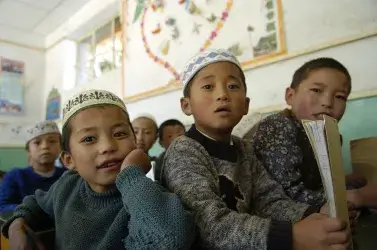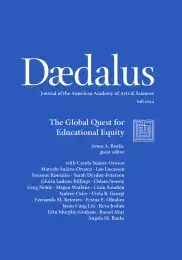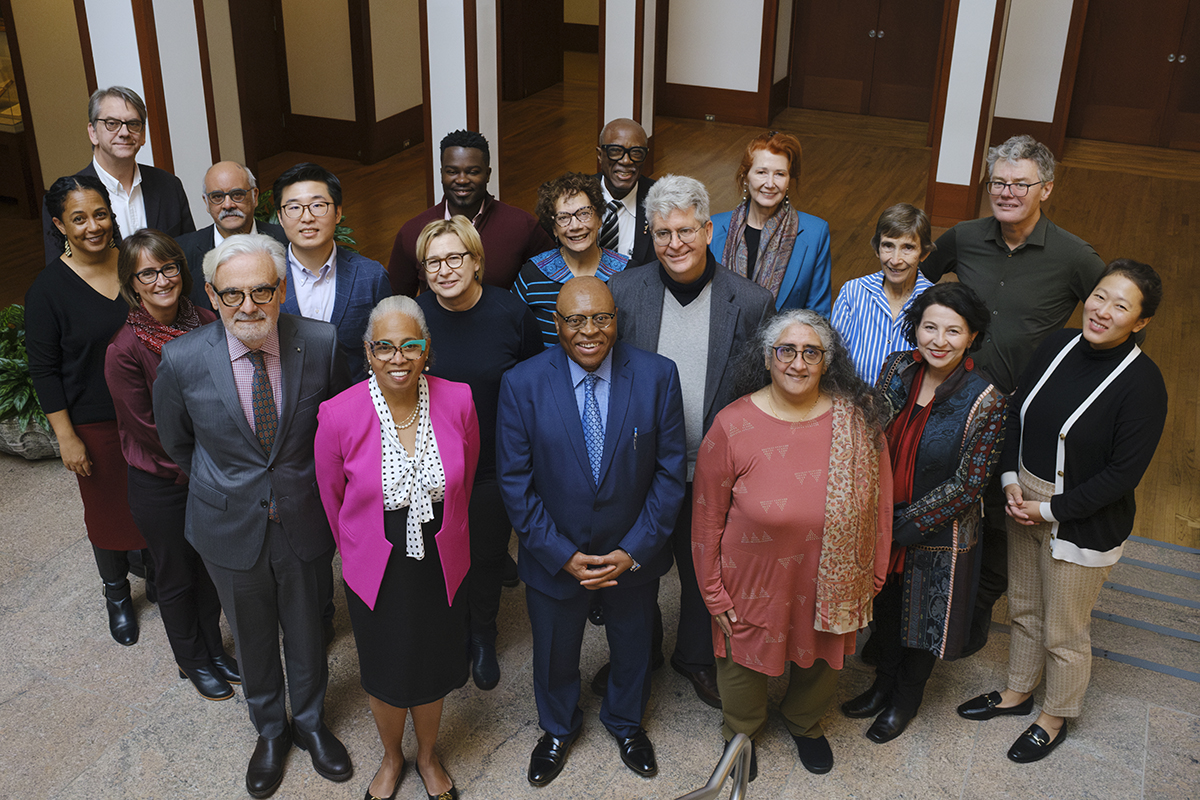
Globalization, Immigrant-Origin Students & the Quest for Educational Equity
Globalization has come to define the modern world. Originally venerated as a force that would bring humanity to the peak of its flourishing through economic integration and positive cross-cultural exchange, globalization has deepened economic inequities, driven the dangerous degradation of the environment, and destabilized regions over fights for resources. Migration, a natural response to this precarity, has swelled, making the children of immigrants a growing, key demographic in schools across many high- and middle-income countries. The resilience, flexible thinking, and multilingualism of immigrant-origin students make them valuable community members in our globalized world. However, their schools are not always equipped to meet their psychosocial needs. While the current primary focus on language acquisition is an important foundation for supporting these students, an equitable whole-child approach is necessary to address their unique challenges and create an environment in which they can flourish.
Migrants & Minorities into Citizens: Education & Membership Regimes Since the Early Modern Period
Schools are one of the institutions that determine the possibilities to participate in society. Therefore, access to education is crucial to the settlement process of immigrants, minorities, and their offspring. Newcomers who join a community have always faced different membership regimes, long before the emergence of the nation-state in the nineteenth century. Such regimes determine whether, to what extent, and under what conditions children of migrants and minorities have access to schools. They also determine whether schools are segregated along religious, racial, or socioeconomic lines. These conditions are not limited to international migrants, but may also apply to internal migrants, such as low-income Chinese people who have moved from the countryside to large cities since the early 1980s and have limited access to (more expensive) urban schools. In this essay, I compare different parts of the world over the past five centuries to understand how polities allow or restrict access to education, and to what extent schools function as gateways to full participation in societies for children of migrants and minorities.
Language Equality & Schooling: Global Challenges & Unmet Promises
In this essay, I examine unmet promises and global challenges for achieving language equality in schooling, with special focus on one of the United Nations’ Sustainable Development Goals, SDG-4, which aims to ensure equitable and inclusive quality education and lifelong learning for all. Language of instruction is a key determinant of student success, but there is limited recognition of the vital role language plays as an intervening variable. Most languages continue to be excluded from education and 60 percent of out-of-school children live in regions where their own languages are not used at school. Inequities arising from unjust language policies combine to trap the poorest in a cluster of disadvantages persisting across generations. Underinvesting in education jeopardizes a range of social benefits. A well-educated population will increase the overall economic prosperity of a nation. I call for first language–based multilingual education as a pathway to schooling equality and sustainable development.
Refugee Education: Aligning Access, Learning & Opportunity
Access, learning, and opportunity are usually conceptualized in a sequential and linear way: with access to school comes learning and with learning comes opportunity. But for most refugee students—and for most marginalized students globally—this model simply does not hold. In settings where students’ mobility and their social, economic, and political rights have massive restrictions, access to school does not translate into learning, and learning does not translate into opportunities. Creating education that enables refugee young people to feel a sense of belonging and prepares them to help build more peaceful and equitable futures requires us to address these misalignments, which are rooted across the ecosystem, from macro-level geopolitical arrangements to micro-level interactions in classrooms. I pose three questions as central in understanding these misalignments: Who is allowed to be where and for how long? Who is responsible for refugee education? And who can feel a sense of belonging? Answering these questions informs how we might work, through policy and practice, toward alignment.
How Pedagogy Makes the Difference in U.S. Schools
Emerging from the modern U.S. civil rights era, scholars have promoted ethnic and multicultural studies as strategies for improving the educational performance of students who have traditionally been marginalized in classrooms nationwide. Among the most marginalized are students who have experienced historic discrimination because of their racial, ethnic, linguistic, and immigrant status. The student population of United States comprises diverse groups. Marginalization and school failure are highest among African American, Latine, Indigenous, and some Asian students. In this essay, I speak to the necessity of more than curricular changes and explore the more than thirty years of research that addresses the demand to employ pedagogical philosophies and strategies that meet the needs of marginalized students. I conclude by describing the impact of COVID-19 on teaching and learning in underserved communities.
Overcoming Historical Factors that Block the Quest for Educational Equity in Canadian Schools
Remedying school inequities in Canada requires actively confronting the challenges connected to Canada’s national identity and history. These challenges uphold historically rooted, ongoing inequities that are tied together by three themes: the legacy of colonialism and the displacement and resource acquisition that provided (and continues to provide) wealth for the ruling elite; enslaved and under/unpaid racialized/migrant labor that built and continues to uphold the infrastructure of the nation-state; and the discourses of Canadian identity centered on the perceived “nice and polite” Canadian and the peaceful multicultural mosaic of its vast land. Any effort to fully understand and address educational projects for change in Canada must engage with these three themes central to Canada’s identity.
The Quest for Educational Equity in Schools in Multicultural Australia
Australia’s migration history has produced one of the most ethnically diverse nations in the world, but this has presented challenges for educational equity. The introduction of multiculturalism in the 1970s coincided with an increasing focus on structural inequities in education. In this essay, we examine the context of changing educational policies and programs over the last half century, arguing that there has not been a steady process of reform involving measures redressing various inequalities but a period of policy turbulence. We consider the impact of the competing logics of multiculturalism—incorporation, recognition, civility—upon educational policy and practice to argue that, together with the consequences of neoliberal reforms, the equitable delivery of multiculturalism in schools has proved challenging. We conclude that multicultural education must refocus on the critical capacities that teachers and students alike need to understand the cultural complexities of a globalized world.
The Quest for Educational Equity in Schools in South Africa
The quest for educational equity in South Africa takes its impetus from the country’s transition to democracy in 1994. The country faced the challenge of overcoming deep systemic inequality—both racial and class-based—caused by three hundred fifty years of colonialism and apartheid. The African National Congress undertook a process to equalize the educational system and expand opportunities for students. Significant progress has been made in addressing issues of race, class, and gender in the thirty years since 1994, but a combination of factors has both reproduced and amplified old inequalities and disparities, particularly those of space and race, and introduced intense new socioeconomic inequalities overlain with challenging cultural and linguistic markers, such as the dominance of English and the loss of indigenous language capacity. Two elements have been pivotal: stubborn legacy effects of apartheid such as poverty in a context of a weakening economy; and complex and contradictory arrangements made at the transition in 1994 that have left privilege, predominantly but no longer only white, largely intact. The COVID-19 pandemic sharpened these inequalities.
The Long Struggle for Educational Equity in Britain: 1944–2023
In this essay, I take the long view in reviewing initiatives for educational equity in Britain, examining both official initiatives and grassroots struggles for equitable educational outcomes over the past eighty years. I frame education policies in the context of other social policies from the immediate post–World War II era, notably the provision of universal health care, welfare, and the changing legal frameworks relating to equalities and immigration over the period. I address the contributions of minoritized communities in the struggle for educational equity, the impact of twentieth-century women’s movements, and more recent student-led initiatives to secure the availability, accessibility, adaptability, and acceptability of education. I identify all these as “acts of citizenship,” whereby communities constitute themselves as citizens and struggle for human rights.
Migration & the Quest for Educational Equity in Germany
Germany has undergone a significant transformation from a nation that saw itself as culturally homogeneous to a society characterized by diversity and immigration. The education system, however, continues to struggle to meet the needs of children and young people from diverse backgrounds. This manifests in forms of unequal treatment and discrimination that impede the effective integration and education of students from different ethnic, linguistic, cultural, and religious groups. This is particularly true for students from nonacademic, low–socioeconomic status backgrounds, as well as for students from immigrant families: categories that frequently overlap. However, there are promising educational interventions and initiatives that address issues of democracy, diversity, and equal opportunity in schools. I provide an overview of select issues in the production and reproduction of inequality in the German school system and in everyday teaching practices, with a focus on including students of immigrant origin.
The Quest for Educational Equity in Mexico
I examine the dynamics of implementing at-scale reforms to provide meaningful educational opportunities to disadvantaged students in Mexico. To effectively reduce social inequality and exclusion, education policies need a mix of system-wide and targeted efforts that are implemented at scale and sustained long enough to become institutionalized. The resiliency of those policies requires an elusive balance between system-wide and targeted efforts, alignment between federal and state initiatives, and supportive politics. However, the politics of implementing system-wide reforms are more contentious than those involving targeted efforts because they disrupt entrenched interests, making such efforts harder to sustain. Targeted policies, while easier to implement, reinforce the segregation of students into different educational tracks of varying quality.
Multicultural Education in Nigeria
Nigeria is the most populous Black nation in the world and richest nation in Africa. It has multiple tribes, cultures, languages, religions, and values. It gained its independence from British colonial rule on October 1, 1960. Even with independence, colonialism has had aftereffects that have exacerbated sociocultural maladies such as tribalism, religious fanaticism, massive corruption, military coups, and devastating conflicts (like the 1967–1970 Biafra-Nigeria War, which took millions of lives). While education is a powerful tool in socioeconomic and political developments, it has not been philosophically changed to respond to the cultural, linguistic, and religious diversities of Nigeria’s citizenry. Can an adequate educational foundation be instituted without valuing the multicultural strengths of Nigeria? Can Nigeria’s progress be advanced without paradigm and power shifts in the education of all students? Can Nigerians’ freedoms be equalized without respect for all tribes? Nigeria must foster multicultural education to advance itself at all levels.
The Quest for Educational Equity in Schools in Mainland China and Hong Kong
In this essay, I introduce how and why minority groups and educational equity are understood and approached differently in Mainland China and Hong Kong. I describe how in the past few decades, China and Hong Kong have reformed their education systems to increase educational equity and I summarize the progress achieved. I also discuss the cultural, political, and social issues and challenges that contribute to the complexity surrounding educational equity in China and Hong Kong, elaborate on how educational equity remains a tricky issue in schools, and how different factors intersect to affect students’ access to educational goods. Finally, I argue that schools in China and Hong Kong should continue both to reform their education systems to enhance the academic achievement and social development of marginalized students and to put more effort into empowering teachers and students to recognize and address the long-standing systemic and institutional obstacles.
Educational Equity in Schools in India: Perils & Possibilities
India is one of the most diverse nation-states in the world. After gaining independence from Britain in 1947, it adopted a constitution that was based on pluralism, secularism, and egalitarianism. This constitutional vision guided the national education policies until very recently. The current moment in all areas of public policy is being defined by the ruling party’s agenda of Hindutva, or Hindu nationalism. In education, the hallmarks of this move have been a rewriting of history to glorify a mythohistoric version of the Hindu past and a call to engage with ancient Indian knowledge systems and traditions. Unfortunately, Hindu nationalism is creating growing rifts between the majority Hindu population and other groups, including Muslims, Christians, and Dalits (formerly known as “untouchables” or “outcastes”). The aim of this essay is to understand what is happening in Indian education and to consider ways to return to an engagement with the constitutional principles of pluralism, secularism, and egalitarianism.
From Girls’ Education to Gender-Transformative Education: Lessons from Different Nations
The examination of gender inequality in education around the globe reveals a multifaceted issue deeply intertwined with persistent challenges within education systems and society at large. Over the past three decades, girls’ education has often been portrayed as a panacea, touted as the solution to a wide array of societal problems, including issues as diverse as high fertility rates and global warming. This essay explores gender disparities in education, employing case studies from Latin America to elucidate the intricate dynamics of this global phenomenon and to illustrate the potential of gender-transformative approaches. Drawing upon two decades of empirical research and theoretical insights from the capability approach, I discuss the linkages between gender, education, and social transformation.
Disrupted Institutional Pathways for Educational Equity in Conflict-Affected Nations
Areas and systems affected by compounded crises, protracted conflicts, and structural violence often struggle to reform education for social reconstruction. At the forefront, we observe tireless and ambitious ventures among donor agencies, government institutions, and international and local organizations. However, in many of these cases, we also witness deepening political gridlock, stagnation, and marginalization that undermine the progress of an empowering education for citizenship that upholds principles of human rights. Causal factors to these institutional failures are often either overlooked, redacted, or undocumented in research. Evidence from Morocco, Iraqi Kurdistan, and, most of all, Lebanon illustrates the extent to which governance systems in education can either hinder or even prevent equity in education.
Constructing Effective Civic Education for Noncitizen Students
Primary and secondary education is essential because it not only provides students with critical literacy and numeracy skills, but also, for many students, it begins their civic education. The goals of civic education vary by country, but a consistent goal is to provide students with the knowledge and skills necessary to be productive members of society. Globally, approximately thirty-six million children are living outside of their country of nationality. With the growing number of migrant children, states are facing two challenges to effective civic education. The first is access to schools, and the second is creating a civic education curriculum that effectively prepares all students to participate in society in ways that align with democratic principles and goals. This essay focuses on unauthorized migrant children’s access to public schools and argues for civic education to incorporate the exploration of membership boundaries so that students, citizen and noncitizen alike, can study unauthorized migrants’ participation in society within the context of membership status. This exploration offers students the opportunity to consider how to better align unauthorized migrants’ lived realities with their legal status–and to better realize democracy’s promise.

